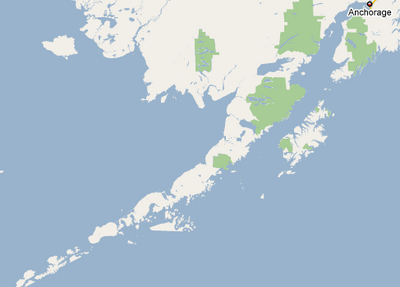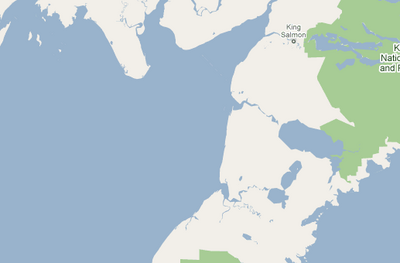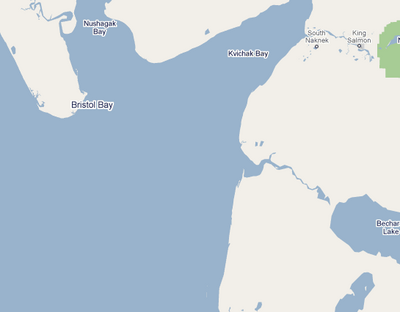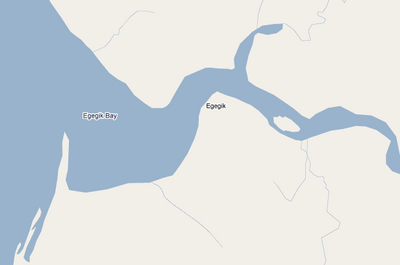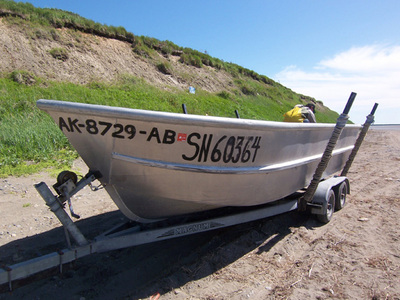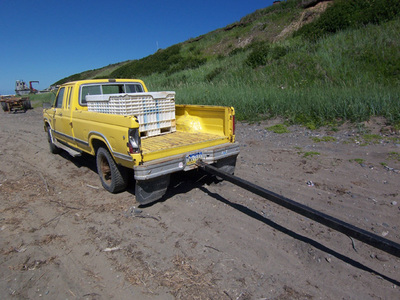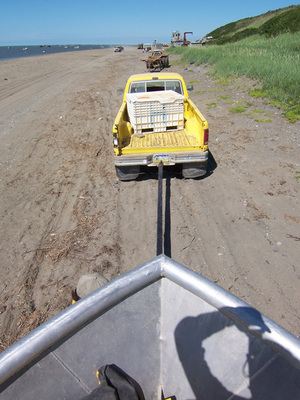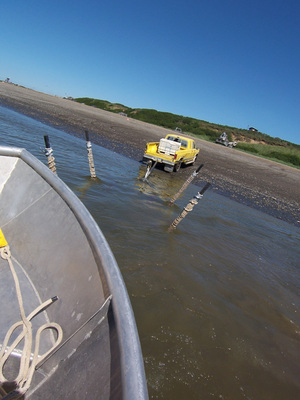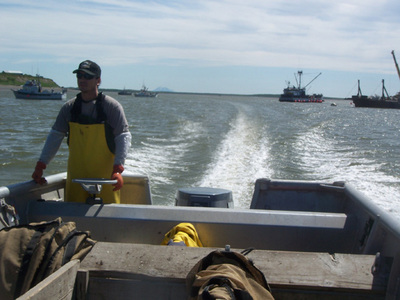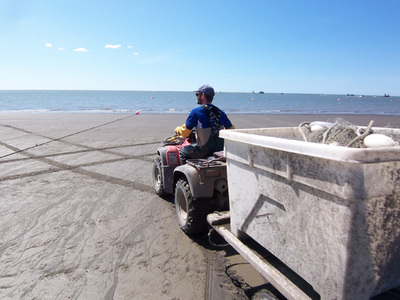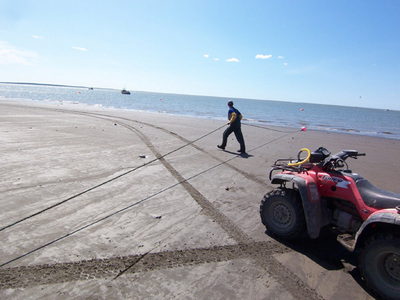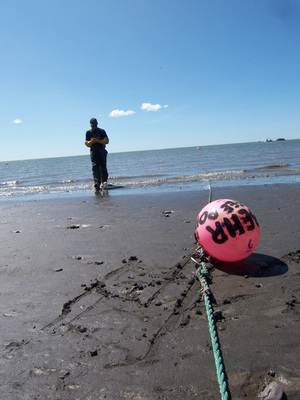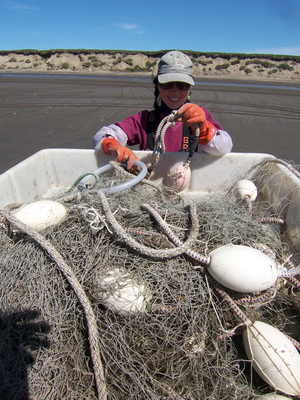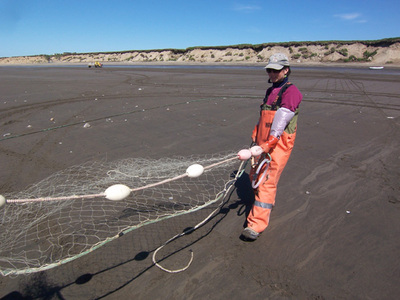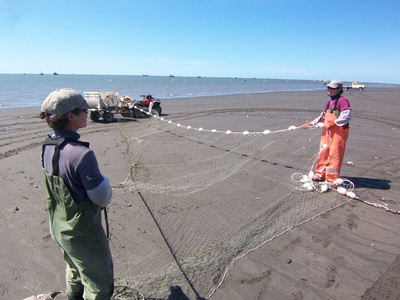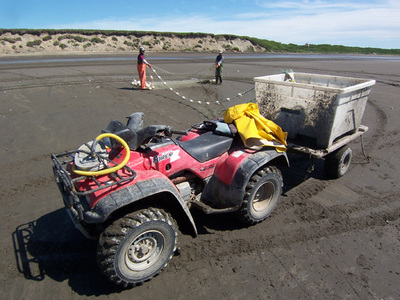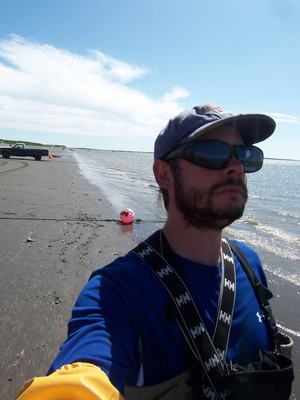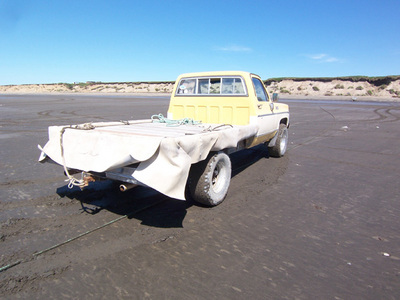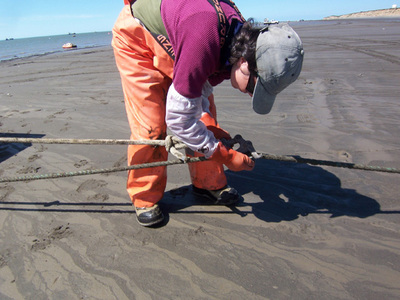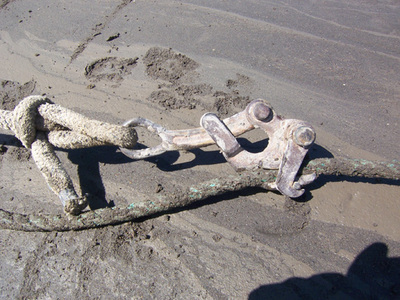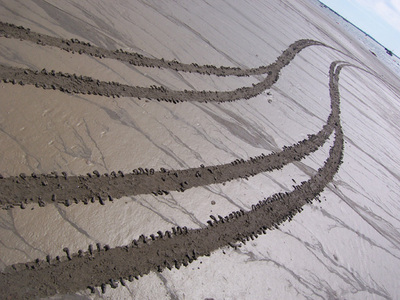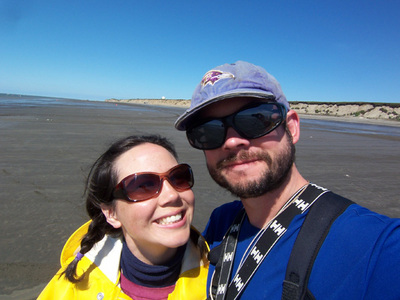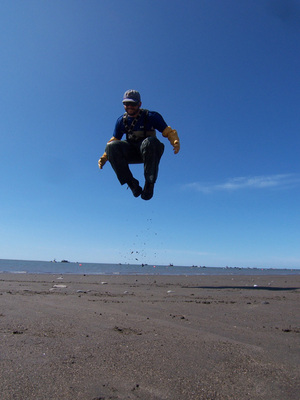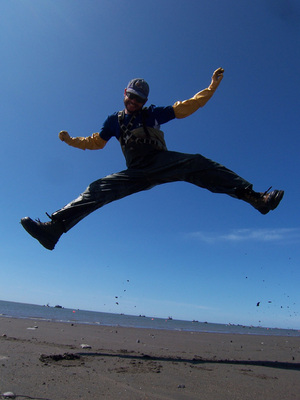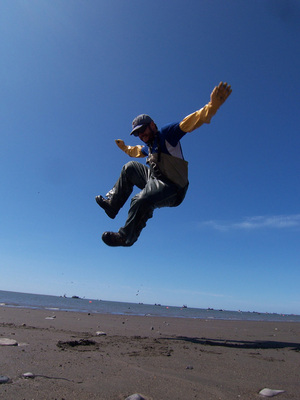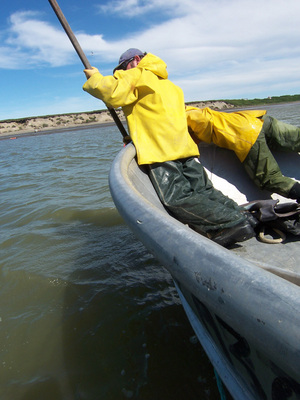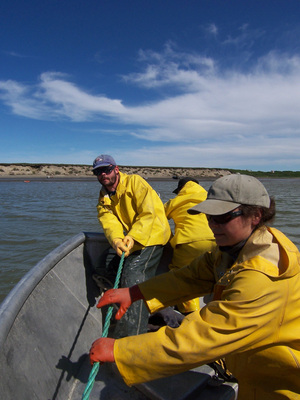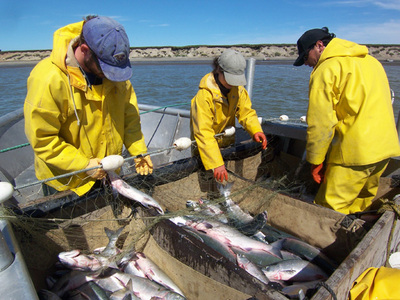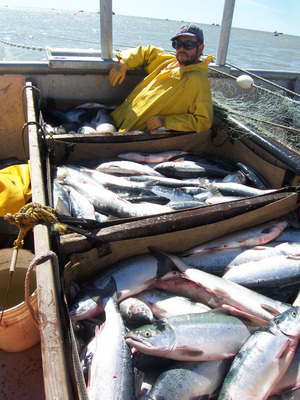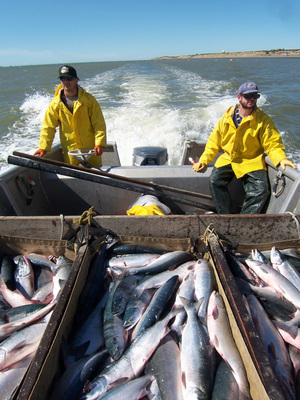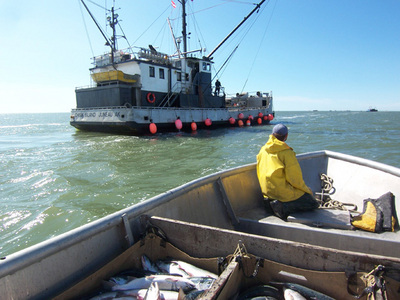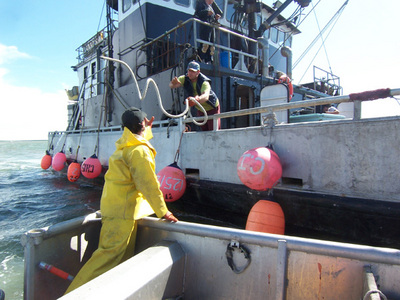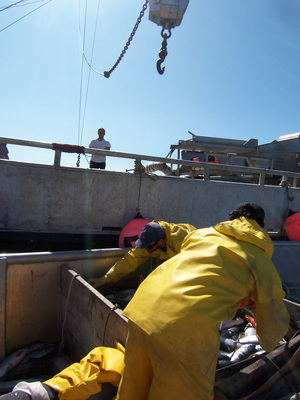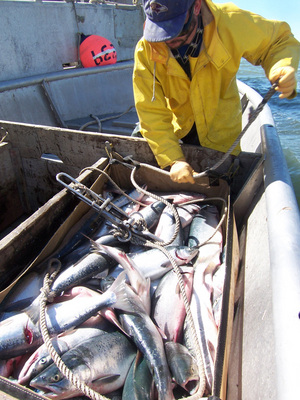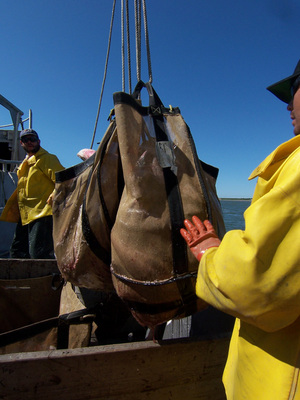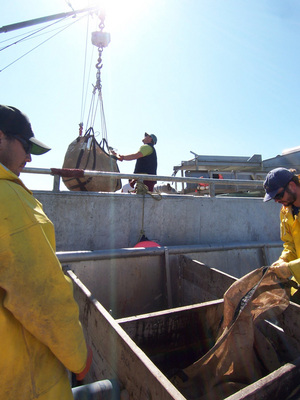« Makers Part 7 | Main | Makers Part 8 »
July 21, 2009
Catching the Fish
Now that you have a comprehensive understanding of the fisherman's garb, I will walk you through his day-to-day industry.
For a bit of background: Robbi's family has been fishing commercially for sockeye (red) salmon for the past 32 summers. They are set net fishermen, which means that they fish from the shore with gill nets (100-yard nets in which the fish are snagged as they try to swim upriver to spawn). They fish in an inlet in Bristol Bay, a huge body of water on the western shore of the Alaska Peninsula, the peninsula that leads southwest from Alaska toward the Aleutian Islands.
The Behr family fishing compound is just across Egegik Bay from the tiny Native fishing village of Egegik (Iggy's real name). There's no permanent, year-round settlement on our side of Egegik Bay.
Fishing is regulated by the Alaska Department of Fish and Game. We listen to the radio at scheduled intervals (usually noon, 3:00pm, and 6:00pm each day) for announcements that let us know when fishing is allowed. Fish and Game tracks the "escapement" of salmon, that is the number of salmon that have successfully made it past all the fishing nets to the spawning grounds. If the escapement is on schedule (meaning the biologist is confident that enough fish will spawn to maintain the fishery over time), we are allowed to fish. If the escapement lags behind traditional numbers, we are not allowed to fish.
Although we catch our fish in nets near the shore, we try to sell as many of them as we can to boats floating out in the middle of the river, so when weather permits we use a metal skiff to "pick" the fish out of the nets and then deliver them to a tender (boat that buys fish from a bunch of fisherman and then delivers them to a processing plant).
Enough reading. Here is our skiff, parked up on the beach.
Here is the truck that pulls it.
The truck pulls the skiff to the edge of the water.
And then we launch.
Robbi's brother takes the boat a few miles to where our fishing sites are.
We tie the skiff to a line while we prepare our nets for the "opening", or the exact moment that we are allowed to start fishing, according to the Department of Fish and Game.
There are many ways to get one's nets into the water. The trick is getting them into the water as quickly as possible once the fishing session has started.
The method we use most often is to pile the net on the ground near the water line and then pull it out into the water using a truck. Each of our fishing sites has a system of rope and pulleys, a huge square with a pulley at each point. By pulling with a truck along one side of the rope, the entire system moves. So we tie one end of the net piled along the shore to the rope and pull on another section of the rope with the truck. As we drive, the net pulls into the water. Once it's in the water, we tie the loose end to the rope. The net is then securely tied to the rope at both ends, and we are permitted to leave it in the water for the duration of the fishing period.
The first order of business is to drive the net (using a four-wheeler) to the right spot on the beach.
Then we move the rope into the correct position (the outgoing tide moves it to the wrong position and we have to put it back before we start fishing again).
Then we have to move the buoy (which marks the place at which we attach the net to the rope) to the edge of the water.
Then we deal with the net. Here it is, piled into a large plastic tote.
Robbi carefully removes the end of the net from the pile.
Next we "stack" the net, carefully keeping the "cork line" (the top of the net, with corks to keep the line afloat) separate from the "lead line" (the bottom of the net, weighted with lead to keep it on the bottom of the river).
Here's another angle on the stacking. See how it feeds out of the tote as we stack it on the beach.
Once the net is stacked, I begin my pre-fishing ritual. There are several complicated steps.
1) Admire the buoy.
2) Inspect the truck.
3) Attach the rope to the truck using the grabby metal clamp thing.
The grabby metal clamp thing is attached to a rope that loops around the truck's hitch. Once it's attached to the rope, the rope will move when the truck does.
4) Admire the lovely patterns the truck tires make in the sand.
5) Take photo for Christmas card
6) Jump
7) Jump
8) Jump
Once all these preparatory steps have been completed (and not a second prior), I get into the truck, turn on the engine, and wait for Robbi to give the signal. Robbi waits about 100 yards away from me, by the net stacked on the beach. Once I've finished pulling the net into the water, she will tie the other end of the net to the rope.
The appointed time arrives and Robbi gives the signal. I drive. She ties the knot. The fish start getting caught in the net. That's the first part of fishing.
The second part involves getting the fish out of the net. This is done entirely by hand. We return to the skiff and climb on board. We use a gaff to grab the net.
We pull the net over the bow of the boat (both the lead line and the cork line).
Then we remove the fish.
This process, called "picking" is one of the hardest things to master. After seven summers, I'm still improving my technique. Robbi is quite masterful.
When we're all done picking, we pause for a moment to rest and admire our catch.
And then we drive the skiff to the tender for delivery.
When we reach the tender, we slow down and pull alongside it.
They throw us ropes and we tie off at the bow and stern.
The tender lowers a hook attached to the end of a boom arm.
We attach the hook to the four corners of the rugged nylon bags into which we have placed the fish as we picked them.
The boom operator then lifts the bag of fish and weighs it (there is a scale between the hook and the boom arm). They write down how much fish we sell and then pay us all at once at the end of the season.
The tender then dumps the fish from the bag into a storage bin (keeping it cool until it is processed).
Those are the basics. There are many other aspects of the fishing, but these are the most glamorous/interesting ones.
This summer the fish came early, so we were ahead of the escapement projections from the start. This meant the biologist felt comfortable letting us fish a lot. And fish a lot we did. In fact, for the last two weeks we were there, we fished every tide but one. This means, in the course of 21 days, I put on (and took off) my rubber suit more than 75 times.
If you have been guilty of romanticizing my time on the tundra, I hope that this post has not been too disappointing.
Posted by bogenamp at July 21, 2009 09:51 PM
